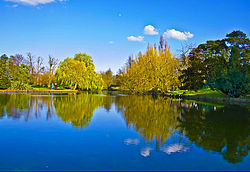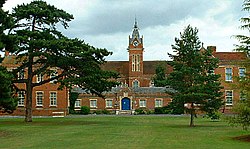Beddington
| Beddington | |
| Surrey | |
|---|---|
 Beddington Park | |
| Location | |
| Grid reference: | TQ305655 |
| Location: | 51°22’16"N, 0°7’55"W |
| Data | |
| Population: | 21,004 |
| Post town: | Wallington, Croydon |
| Postcode: | SM6, CR0 |
| Dialling code: | 020 |
| Local Government | |
| Council: | Sutton |
| Parliamentary constituency: |
Carshalton and Wallington |
Beddington is a suburban settlement and ancient parish in the Wallington Hundred of Surrey. It lies within the metropolitan conurbation, between Carshalton and Croydon. The ancient parish includes Wallington after which the hundred is named. The latter was in the 13th century shown on local maps as Hakebrug, and named after a bridge on the River Wandle. The locality has a landscaped wooded park at Beddington Park – also known as Carew Manor; and a nature reserve and sewage treatment works in the centre and to the north of its area respectively. The population of Beddington according to the 2011 census is 21,044.
Contents
History
The settlement appears in the Domesday Book as Beddinton(e) held partly by Robert de Watevile from Richard de Tonebrige and by Miles Crispin. Its Domesday Assets were: 6 hides; 1 church, 14 ploughs, 4 mills worth £3 15s 0d, 44 acres of meadow, woodland worth 10 hogs per year. It rendered: £19 10s 0d per year to its feudal overlords.[1] In 1901 it consisted of 3127½ acres, of which 1,439 acres were arable land, 614 permanent grass and 45 woods. As this was before the expansion of Wallington, it extends on the south over the chalk downs at Roundshaw and northwards on to the London Clay. Lavender and medicinal herbs were grown commercially in the parish. The population in 1901 was 4,812. The parish was bounded on the north by Mitcham Common, and the three parishes of Croydon, Beddington and Mitcham met on the railway line by Beddington Lane station.[2]
The 1911 Victoria County History documents Beddington in the period of its shrinkage.
Wallington is now more urban than Beddington; the hamlet in 1901 had a population of 5,152 on an area of 312 acres. In prehistoric times it also appears to have been the more important place, since it gave its name to the hundred. It is possible that the Roman remains mentioned above may be a relic of a formerly important place, and that its name may preserve the memory of the Wealas, the Romanized Britons, whom the Suthrige found here when Britain was [mostly] becoming England. In historical records, however, Wallington is not a place of importance. There was a chapel, but there is no record of a parish church. In Bishop Willis's visitation of 1725 the chapel is described as partly used for a barn, no service having taken place [in memory]. It was ruinous later in the century and was pulled down in 1797. There were extensive common fields, as was usual in the parishes on the north side of the chalk range. They were inclosed under an Act of 1812. In 1835 a system of allotments was established, which seems to have flourished for a time. A few old houses remain at Wallington Corner, but none of these appear to date from earlier than the beginning of the 19th century.[2]
A parish hall was built at Wallington in 1888, following its church and parish being set up in 1867 (in Beddington at the time). Holy Trinity Church school was built in 1896; the High School for girls was built in 1895 and enlarged in 1905. Thus it came about that Wallington took up most of the land of Beddington.[2]
A static inverter plant of HVDC Kingsnorth stood here in the late 20th century.
Beddington Mill
The Domesday Book mentions two Mills at Beddington, and the current one is thought to have been the site of one of these. Once erroneously thought to have been owned in the late 16th century by Sir Walter Raleigh, an early 17th-century lease shows that it was in fact owned by the Carew family as a flour mill. In 1805 it was a snuff mill with a new owner, and it changed hands several times before being burnt down and replaced by the current building in 1891-2 by Wallis & Co as a flour mill and bakery.[3]
The old – 18th-century or earlier – mill house remains to this day.
Beddington Park
Carew Manor
Beddington Park was the former manor house of the Carew family, lost to money lenders and bad debts by Charles Hallowell Hallowell Carew in the 1850s.[4] The Domesday Book mentions two Beddington estates and these were united by Nicholas Carew to form Carew Manor in 1381. The Manor, once a mediæval moated house, was home to the Royal Female Orphanage from 1866 until 1968. It now contains council offices and Carew Manor School.
In about 1591 Sir Walter Raleigh secretly, and without royal permission, married one of Queen Elizabeth I's maids of honour, Elizabeth Throckmorton of Carew Manor. Raleigh spent time in the Tower of London for this and Elizabeth was expelled from the court but the marriage appears to have been a genuine love-match and survived the imprisonment. A popular story is that when Raleigh was beheaded by James I in 1618, Elizabeth claimed his embalmed head and kept it in a bag for the rest of her life. His body was buried in St Margaret's, Westminster, and after his wife's death 29 years later, Raleigh's head was returned to his tomb and interred at St. Margaret's Church.[5]
The Grade I listed great hall](or banqueting hall),[6] containing a fine hammerbeam roof, survives from the mediæval house. In the grounds are part of the orangery built in the early 18th century around orange trees planted by Sir Francis Carew (claimed to be the first planted in England) and an early 18th-century Grade-II* listed dovecote.[7]
Archaeologists have discovered a Tudor garden including a grotto at Carew Manor, believed to have been created by Sir Francis Carew in the 16th century. Its exact location has not been disclosed in order to protect it from looting.[8]
As well as Carew Manor, the family have given their name to a street in nearby Wallington, Carew Road.
St Mary's Church
The Grade-II* listed 14th-century flint parish church of St Mary's occupies a prominent position in Beddington Park, immediately south of what is now Carew Manor School. It contains an organ screen by William Morris. The church is designated at Grade II* for the following principal reasons:[9]
- It has substantial amounts of fabric from the 14th and 15th centuries
- It was extensively restored and provided with an extremely elaborate and interesting mid-Victorian decorative scheme.
- It has monuments and other fixtures of importance from circa 1200 to the 20th century, including font and Carew tombs.
- The Morris and Co. organ is of special note, and the Last Judgment reredos is unusual.
Transport
Beddington is served by the Wimbledon branch of the Tramlink network. The nearest railway station is Waddon.
The area is served by a number of bus routes, all of which are operated by Transport for London.
- 407 – Sutton to Caterham
- 410 – Wallington to Crystal Palace
- 455 – Wallington to Purley, Old Lodge Lane
- 463 – Pollards Hill to Coulsdon South
Namesakes
Beddington Heights in Calgary is named after Beddington, Surrey.
References
| ("Wikimedia Commons" has material about Beddington) |
- ↑ Surrey Domesday Book
- ↑ 2.0 2.1 2.2 H.E. Malden, ed (1912). "Parishes: Beddington". A History of the County of Surrey: Volume 4. Institute of Historical Research. http://www.british-history.ac.uk/report.aspx?compid=43048.
- ↑ "Information about the historic mill in Beddington". London Borough of Sutton. https://www.sutton.gov.uk/index.aspx?articleid=1315.
- ↑ "Re Charles Hallowel Hallowell Carew, Esquire of Beddington Park, in the county of Surrey". 15 October 1856. London Gazette. http://www.london-gazette.co.uk/issues/21931/pages/3362/page.pdf.
- ↑ Lloyd, J & Mitchinson, J: The Book of General I.
- ↑ Beddington Place (Great Hall Only), Sutton
- ↑ Pigeon House to North West of Beddington Place, Sutton
- ↑ "Carew Manor • Wandle Valley" (in en). https://wandlevalleypark.co.uk/locations/sutton/carew-manor/.
- ↑ Parish Church of St Mary the Virgin, Sutton


